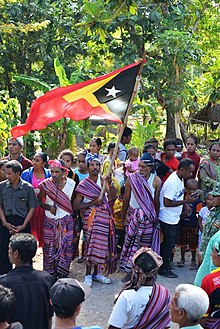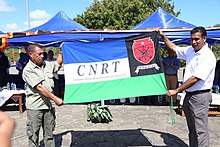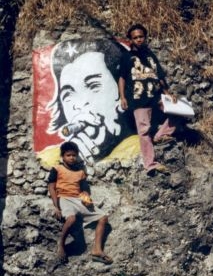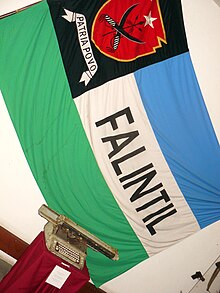Flag of East Timor
| Flag of East Timor | |
|---|---|
 |
|
| Vexillological symbol : |
|
| Aspect ratio: | 1: 2 |
| Officially accepted: | May 20, 2002 |
The flag of East Timor was first used as the national flag by FRETILIN when the party declared the independence of the Portuguese Timor colony on November 28, 1975 . After the country was occupied by Indonesia , the flag was not adopted as the national flag of East Timor until independence was restored in 2002 .
Description and meaning
The base of the national flag is red. A yellow triangle connects the corners of the flag on the mast side ( leech ) with the center of the flag. On the yellow is a black triangle, the tip of which extends a third into the flag. In the center of the black triangle there is a five-pointed white star, one point of which points into the upper corner of the mast side. The size of the star corresponds to a third of the flag's height.
The flag was officially adopted for the first time with the Constitution of the Democratic Republic of Timor-Leste on November 28, 1975. The symbolism of this flag has been given the following meaning:
- Black represents the four centuries of colonial oppression.
- The yellow arrowhead reminds of the struggle for independence .
- Red stands for the blood shed by the population.
- The white star symbolizes the hope for a better future .
Today, both the colors and their meaning are given in the new Constitution of the Democratic Republic of Timor-Leste of 2002 ( Part I, Section 15 ):
- Black symbolizes the obscurantism that must be overcome.
- Yellow represents the country's wealth .
- Red symbolizes the struggle for national freedom.
- White stands for peace .
Variations

The tones of the individual colors are not precisely defined in the constitution. The Independence Day Celebrations Committee of the United Nations Interim Administration for East Timor (UNTAET) specified the light orange ( PMS 123 ) as the correct shade of yellow, which can usually be found on official flags. A light yellow is also widespread in flag images in books or on the Internet, as well as in the flags used in East Timor. According to the UNTAET source, the red corresponds to the tone PMS 485. Here, too, there are versions with a light red in East Timor. Even darker versions only appear as flags, but not as flags. Although the UNTAET indicates the size of the black triangle with a quarter of the flag length, the existing flags and images all have a triangle with a size of one third.
There is disagreement about the correct proportions of the flag. While the flag of 1975 always had the ratio of 2: 3 common in most of Europe, with the independence of East Timor, flags with a ratio of 1: 2 also appeared in official use. The reason for this is probably that these flags are made in Australia and the proportions 1: 2 are common here. A clear uniform regulation was initially pending, but Law 02/2007 on national symbols shows the image of a flag with a 1: 2 ratio in the appendix. Furthermore, Article 4 of the law lists the various flag formats in which the flag made of fabric is to hang in public offices, barracks, private and state schools. Type 1 consists of a cloth with a width of 45 centimeters, type 2 consists of a cloth with a width of 90 centimeters, type 3 with a width of 135 centimeters and so on up to type 7 with a width of 315 centimeters. However, the article in paragraph 2 expressly allows smaller and larger flags as well as flags with sizes in between, as long as the proportions are adhered to.
You often see flags with the star pointing straight up with its top tip. This was often the case with the 1975 flag. But today's constitution clearly states that the star should point with a point in the upper left corner. This is also followed by the illustration in Law 02/2007.
The flag of East Timor, which was used for the independence celebration on May 20, 2002, had a straight star despite the clear guidelines. It also had an aspect ratio of 1: 2 and used the bright yellow in combination with the bright red.
 ? Variation with light yellow and dark red.
? Variation with light yellow and dark red.
 ? Historical variation with straight star and 2: 3 aspect ratio
? Historical variation with straight star and 2: 3 aspect ratio
 ? Flag of the independence
? Flag of the independence
ceremony of May
20, 2002
history

Until independence from Portugal , the Portuguese Timor colony only used the flag of Portugal . The Liurais , the traditional rulers of Timor, drew part of their claim to power from sacred objects ( lulik ) that were owned by the ruling families. When the Portuguese subjugated the Timorese, they gave the Liurais as vassals the Portuguese flag, which in the eyes of the Timorese, just like the flagpole, became sacred objects that legitimized the rule of the Portuguese and the Liurais who were loyal to them. In the Mambai culture in particular , the cult of the flag was of central importance. According to their original myth, the world order is created by two brothers. The older brother, from whom the peoples of Timor are descended, has ritual power over the cosmos. The younger brother has power over the social order. The non-Timorese peoples descend from this, in this case the Portuguese. The myth tells of the loss, search and recovery of a lost, sacred object, namely the Portuguese flag. This sacred meaning of the blue and white flag created some problems when the flag of Portugal was changed in 1910 when it switched from monarchy to republic.
In 1961, a small, left-wing Timorese resistance movement - the Bureau de Luta pela Libertação de Timor (BLLT) - used a flag that already featured some elements of today's national flag. It consisted of a yellow-rimmed black disc with a five-pointed white star on a red cloth. The BLLT later established a short-lived government-in-exile in Jakarta called the United Republic of Timor , which used the same flag.
In 1967 there were proposals for individual flags for the individual Portuguese colonies , in which the coat of arms of the colony was added to the flag of Portugal in the lower right corner. However, the proposals were never implemented.
 ? Flag of Portugal
? Flag of Portugal
(1830-1910) ? Flag of the Bureau de Luta pela Libertação de Timor and the United Republic of Timor (1961)
? Flag of the Bureau de Luta pela Libertação de Timor and the United Republic of Timor (1961)
 ? Proposal for a flag of Portuguese Timor in 1967
? Proposal for a flag of Portuguese Timor in 1967
After the Carnation Revolution in Portugal, parties were also allowed in Portuguese Timor. The dominant, left-wing East Timorese party, the Frente Revolucionária de Timor-Leste Independente (FRETILIN), used the same colors as the BLLT in its party flag and also the white star on a black background. Apart from their political orientation, there are no connections between the two organizations. The extent to which the flag served as a model or simply common socialist symbols such as the five-pointed star and the color red were used on the party flag is not clear. Based on the flag of FRETILIN, legend has it that the resistance fighter Natalino Leitão designed today's national flag on the night before independence from Portugal was proclaimed on November 28, 1975. The beginning occupation of the country by Indonesia had forced FRETILIN to take action. Nowadays, November 28th is East Timor’s National Day, when official buildings are flagged. Just nine days after the declaration of independence, Indonesia openly began invading East Timor. Natalino Leitão was killed in the process.
The declaration of independence had only been recognized by a few states. Indonesia was politically supported by the USA and Australia , as there was fear of a second Cuba due to the left orientation of FRETILIN . To what extent the red base color and the certain similarity of the flag design to the flag of Cuba support this assumption is debatable. It can only be assumed that the flag of Cuba or the flag of Mozambique were the model for Leitão's triangular design. At least there was and is sympathy for Cuba and especially for Ernesto Che Guevara in East Timor . To Mozambique and its ruling party FRELIMO FRETILIN had already at that time a close relationship.

Until 1999, East Timor was ruled by Indonesia as a province, while it was internationally regarded as a "dependent territory under Portuguese administration" . As an Indonesian province, it also received a provincial flag, but this was only used in the governor's office, as was common with all provincial flags. The flag of Timor Timur , as East Timor was officially called at that time, showed the provincial coat of arms on an orange background. During the occupation the flag of Indonesia was used, while the liberation movement Conselho Nacional de Resistência Timorense (CNRT) used its own blue-white-green-black flag. The design was largely adopted from the flag of the FALINTIL , the military arm of the East Timorese resistance that emerged from the FRETILIN party army. The only changes were the inclusion of the black lettering "CNRT" on the white stripe and the change of the symbols in the sign. With the FALINTIL there was a yellow, five-pointed star, two traditional swords ( suriks ) and three feathers. The CNRT used a spear and two arrows instead of feathers, the star was now white. The shield in the flag of the CNRT can be found in a slightly different form with the same elements in the later first coat of arms of East Timor (2002-2006) after the restoration of independence. The defense forces of East Timor , in which the FALINTIL were absorbed, now use the spear-and-arrows version on their uniforms. At the independence referendum in East Timor in 1999 , the population was finally able to choose between full independence and staying with Indonesia as the Special Autonomous Region of East Timor SARET . Article 20 of the draft SARET constitution provided for the possibility of adopting one's own coat of arms, but not one's own flag. Instead, the flag of Indonesia should continue to be used.
When the United Nations took control of East Timor in 1999, it used the United Nations flag . A discussion began as to which flag a future independent East Timor should use. At the first East Timorese National Convention from April 23 to 27, 1998 in Peniche (Portugal), the delegates of the Timorese parties decided on the flag of the CNRT as the provisional flag of East Timor. In the 1999 referendum on independence, the UN had shown the Indonesian flag to remain with Indonesia and the CNRT flag for independence on the ballot papers to aid decision-making.
At the Olympic Games in Sydney in 2000, four East Timorese athletes took part as Independent Olympic Athletes under the flag of the Olympic Games because East Timor was not yet independent and there was no National Olympic Committee .
However, the flag of the CNRT did not find popular support. At demonstrations in and outside East Timor almost only the old flag from 1975 and the FRETILIN flag were shown. In the end, the flag from 1975 was used. Another reason might have been the overwhelming majority of FRETILIN in the new parliament . But the Partido Socialista de Timor (PST) also called for the red, yellow and black flag. The flag was officially reintroduced on May 20, 2002 when the United Nations flag was lowered and the East Timor flag was hoisted at midnight. The pulled down UN flag was wrapped in a woven, traditional Timorese cloth ( tais ) to protect its mystical, spiritual powers. This flag became a symbol of liberation and protection for the Timorese.
There are voices in East Timor calling for the national flag to be changed, as the current flag is a symbol of FRETILIN. Most parties and most of the population do not follow this demand.
Flag of Indonesia (1975-1999)
 ? Flag of Timor Timur.
? Flag of Timor Timur.
 ? first version of the flag of the FALINTIL
? first version of the flag of the FALINTIL
 ? Flag of the CNRT (semi-official 1998-2002)
? Flag of the CNRT (semi-official 1998-2002)
Flag of the F-FDTL
United Nations flag (1999–2002)
Flags and symbols of the municipalities of East Timor
Originally, there were no separate flags for the communities of East Timor . However, during the colonial period between 1962 and 1975 , Dili was the only place in Portuguese Timor to have a municipal flag that corresponded in design to the Portuguese municipal flag. It was eight-fold green and white and showed the city's coat of arms in the center: red, a sandalwood tree in silver between two bundles of arrows with halberds and a hunting spear. Above the coat of arms is a brick crown with five towers, which represent Dili's status as the capital of an overseas province. In addition a banner with the words "O Sol logo em nascendo vê primeiro" (Where the sun was born first). As a sign of solidarity, the Dilis flag was hung in Lisbon's city hall in 1991 .
Since 2015, the municipalities have been using logos and coats of arms as symbols, which are then also presented on flags with a plain background. The special administrative region Oe-Cusse Ambeno has a green flag with a logo and the municipality of Manufahi has an orange flag with the coat of arms. Baucau shows his coat of arms on a white background.
Logo Aileus
Logo Cova Limas in Tetum and Portuguese
Other flags in East Timor
In the course of the last few years more and more flags of authorities, schools and other institutions have appeared. As a rule, they are single-colored flags with the logo or coat of arms of the organizations. The country's football clubs also adorn themselves with logos and flags.
The flags of the political parties of East Timor are varied. They serve as advertising media at political events and were also shown on the ballot papers for the parliamentary elections on June 30, 2007 as identification marks for illiterate people . The importance of the party flags for supporters was made clear by three incidents that took place during the unrest after the 2007 parliamentary elections. At that time, supporters of FRETILIN had hung up their flags in their eastern strongholds as a sign of protest against the new government. As a result, Australian troops allegedly vilified and stole three FRETILIN flags. The Australian commander, Brigadier John Hutcheson , personally returned one of the flags and regretted the incident. The other two flags were returned through other authorities. FRETILIN General Secretary Alkatiri nevertheless demanded the withdrawal of the Australians because they were no longer neutral.
During Catholic processions and celebrations, one sees blue-white and yellow-white flags, the latter partly with red crosses. Blue and white (as it was also found on the former flag of Portugal) are the traditional colors of Our Lady of Conception (Nossa Senhora da Conceição) . Maria is considered the country's patron saint. Yellow and white are the colors of the Catholic Church (see also: Flag of the Vatican City ).
The veterans organization CPD-RDTL originally displayed the national flag of East Timor at their demonstrations. At the end of 2012, however, flags were used whose design is reminiscent of the flag of the Bureau de Luta pela Libertação de Timor from 1961.
Others

After independence, each village in the country received a copy of the new national flag, which was presented to them in a solemn ceremony. Consciously or unconsciously, one follows the Portuguese tradition, in which the vassals were given the Portuguese flag.
In the song Timor by the Colombian singer Shakira , which is about the violence in East Timor in 1999 and the lack of reporting about it in the western world, one line reads “For our flag, we die or kill” (“For our flag we die or we kill "). There are no official honors of the flag, such as a flag anthem based on the model of Bolivia or a mention in the national anthem , as well as a special day of the flag , which some expected as a unifying symbol in such a young nation, but which is not in the Portuguese tradition corresponds.
Since August 1, 2011, the national flag has been set in front of public facilities on the first Monday of every month. Likewise on February 2nd ( East Timor’s Defense Forces Day FDTL), March 27 ( East Timor’s National Police Day PNTL) and August 20 (FALINTIL Day). The flag is set at 8 a.m., employees and officials of the facility are all present and sing the national anthem.
During the celebrations of the seventh anniversary of independence on May 20, 2009, the national flag fell to the ground. Many Timorese saw this as a bad omen. At the flag ceremony in 2002, the flag did not flap in the wind and violent unrest broke out a few months later . The opposition party FRETILIN saw the renewed incident as a sign that the government was in trouble and one of the largest newspapers in the country, the Timor Post , reported the incident on the front page.
In 2016 MPs Manuel Castro , Manuel Guterres and Natalino dos Santos Nascimento criticized the fact that more and more people are writing on the flag, for example with signatures. From the politicians' point of view, this is a "crime" that the police should take action against. The flag, which was bought “with bones and blood”, is desecrated as a result.
Web links

- When East Timor first flew its flag in defiance (English)
- Flags of the world - East Timor (English)
- The national symbols of East Timor on the official government website
photos
- Setting the flag of East Timor at the UN ( Memento from January 15, 2007 in the Internet Archive )
- Flag in Com / East Timor. Example of a flag with dark yellow.
- Flag of East Timor on the National Parliament. Example of a flag with light yellow. ( Memento from January 5, 2011 in the Internet Archive )
- Flag of East Timor at a demonstration. Example of a flag with a straight star.
- The flag of East Timor on a postage stamp ( Memento from June 2, 2011 in the Internet Archive )
supporting documents
- Constitution of the Democratic Republic of Timor-Leste (English)
- Images and information about the flags of East Timor on FOTW (English)
- Design template for the flag of East Timor according to UNTAET
Individual evidence
- ↑ Lei No. 02/2007, Símbolos Nacionais (German: Law No. 02/2007, National Symbols). (PDF, 584 kB) March 6, 2007, archived from the original on June 21, 2007 ; Retrieved May 15, 2015 (Portuguese).
- ^ Image from the East Timor Sun, May 20, 2002, Independence Ceremony. (No longer available online.) Formerly in the original ; Retrieved November 10, 2007 . ( Page no longer available , search in web archives )
- ^ Flag at the independence ceremony in Suai / Cova Lima , accessed on May 15, 2015.
- ^ Geoffrey C. Gunn: History of Timor. ( Memento of the original from March 24, 2009 in the Internet Archive ) Info: The archive link was inserted automatically and has not yet been checked. Please check the original and archive link according to the instructions and then remove this notice. Technical University of Lisbon (PDF file; 805 kB)
- ↑ Monika Schlicher: Portugal in East Timor. A critical examination of the Portuguese colonial history in East Timor from 1850 to 1912 . Abera, Hamburg 1996, ISBN 3-931567-08-7 , ( Abera Network Asia-Pacific 4), (also: Heidelberg, Univ., Diss., 1994).
- ^ Flags of the World - East Timor: flag proposal of 1967
- ↑ Flags of the World - Indonesian provincial flags
- ↑ Flags of the World - Flags in the (rejected) SARET
- ^ Andrea K. Molnar: Died in the service of Portugal
- ^ Flags of the World: Díli District (East Timor), Portuguese era municipal flag
- ↑ Legislacao.org: Act of October 1, 1962
- ↑ ANMP Boletins
- ↑ AKI, August 20, 2007, East Timor: Australian troops provoke more unrest claims biggest party ( Memento of the original from December 22, 2015 in the Internet Archive ) Info: The archive link was inserted automatically and has not yet been checked. Please check the original and archive link according to the instructions and then remove this notice.
- ↑ Antara: Go home, East Timor ex-PM tells Australian troops , August 20, 2007 ( page no longer available , search in web archives ) Info: The link was automatically marked as defective. Please check the link according to the instructions and then remove this notice. (Unavailable)
- ↑ The Dili Insider: CPD-RDTL Maliana Demo June 29 , 2009 , July 1, 2009 , accessed January 26, 2013
- ↑ Timoran.com: Lere: 2013 Rezolve Problema CPD-RDTL , December 21, 2012 ( Memento of the original from January 12, 2013 in the Internet Archive ) Info: The archive link was inserted automatically and has not yet been checked. Please check the original and archive link according to the instructions and then remove this notice. , accessed January 26, 2013
- ↑ HP Grumpe: East Timor
- ↑ East Timorese government press release of July 30, 2011: Flying the National Flag on Solemn Days
- ^ Notes from Abroad, May 21, 2009, Dropping the Flag
- ↑ Timor Agora: RISKA 'BURADU ”BANDEIRA RDTL, PN HUSU PNTL HALO KAPTURASAUN , August 4, 2016 , accessed on August 4, 2016































